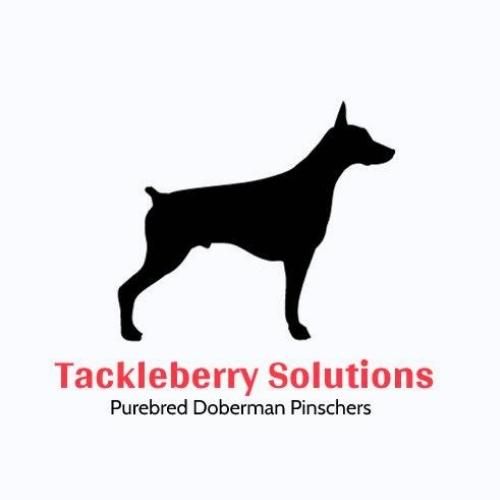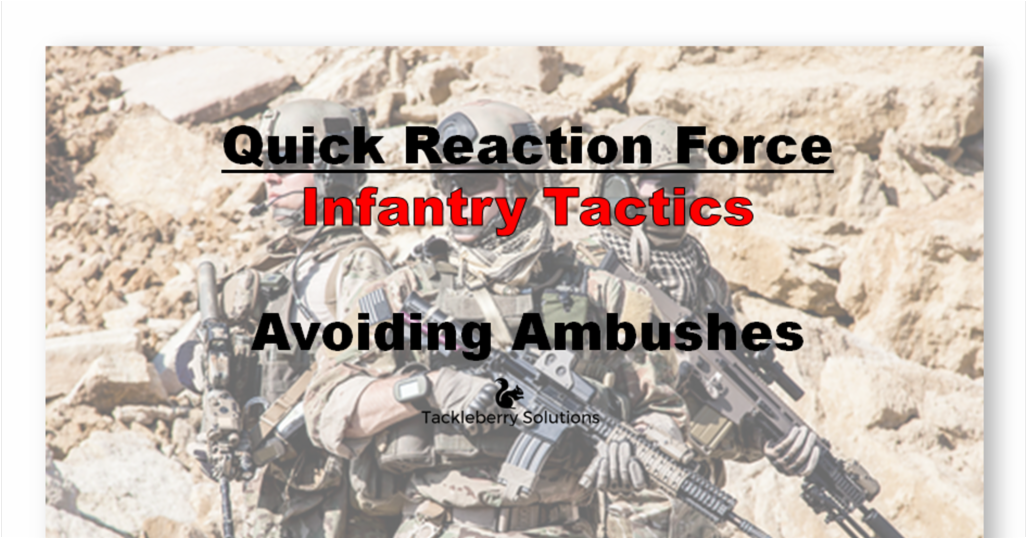Wartime Tactics
How To Form Your Own Platoon as a Quick Reaction Force Using Infantry Tactics
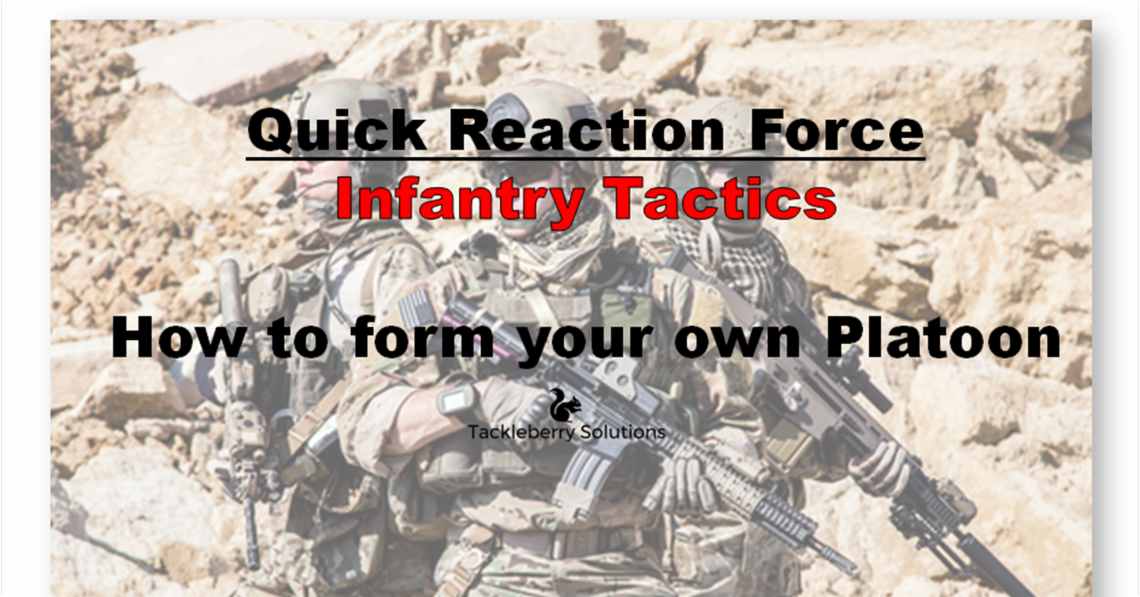
This article is part of a series we are using to teach QRF Infantry Tactics. Here is an outline of the free lessons. They are numbered in the order they are taught in the printed book.
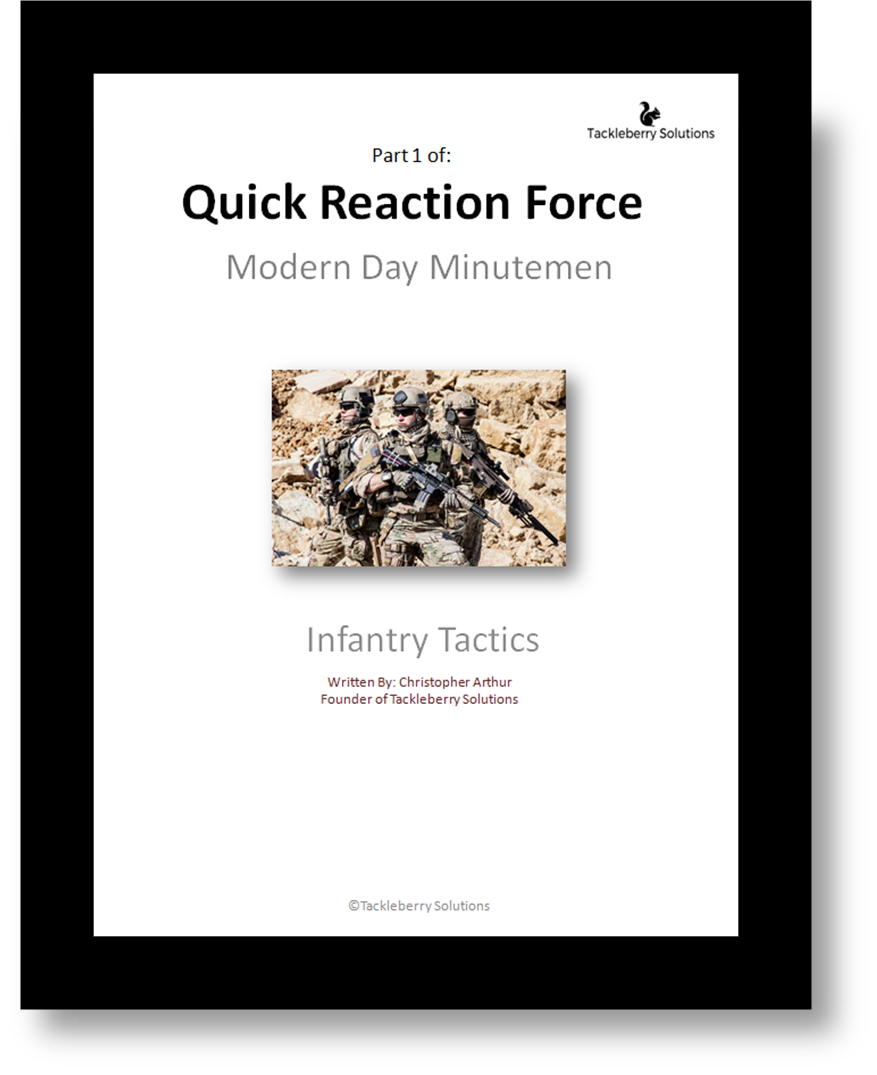
- How to Form Your Own Platoon
- How to Travel During Wartime Without Getting Ambushed
- Hand & Arm Signals - Communicate Silently
- Prisoners of War
- How to Remove the Injured From Battle
- Reaction to Contact (How to Respond if You Get Attacked)
- How to Stop an Armored Vehicle
- Convoys and Obstacles
- How to Identify, Locate and Avoid Landmines
- Fighting Back: How to Ambush Your Enemy
- Fighting Back: Tactical Formations
- Breaking Contact (How to Retreat)
- How to Conduct TCPs (Traffic Control Points)
- A Letter to the Commander (How to Keep Your Men Alive)
- A Story of Battle (What a Real Ambush Looks Like and How I Lived Through It)
What is a platoon?
A platoon is a group of men that comprise of two sections of around 6 soldiers. They are headed by the platoon Sergeant and Lieutenant. Keep reading to find out how they are organized, what you need in each team and how to make proper tactical formations to keep your platoon from getting killed.
Below you will see a summery of the article. Each section is linked so that you can go straight to the topic you're interested in learning about. Use the "Back to Top" button on the bottom right to navigate back up to the article summery if you want to view a different topic. Or you can simply scroll up or down if you want to take the time to do so.
If you have any questions at all about the tactics or methods mentioned in this article, you can ask by either leaving a comment at the bottom of the article, sending us an email to prepare@tackleberrysolutions.com or you can even call Arthur directly at 919 - 223 - 7741.
Article Summery
How to form your own platoon as a Quick Reaction Force using Infantry Tactics
- Warning
- Introduction
- Platoon Breakdown
- Formations
- Stopping/Pausing While in Formation
- 2 Man Wedge (Open Terrain)
- 3 Man Wedge (Open Terrain)
- 4 Man Wedge (The Diamond)
- Standard Wedge (Open Terrain)
- Ranger File (Busy Terrain)
- The Alpha Alpha
- Little Tidbits that Could Save Lives
- Team Movement & Planning Ahead
- Definitions
Warning!
These are wartime tactics – not peacetime tactics. Some of these methods may be highly illegal. We do not advocate the use of this knowledge to hurt the innocent. Be sure to know the laws in your area.
Tackleberry Solutions or anyone associated with Tackleberry Solutions will not be held liable for the use of this information. You are responsible for your own actions.
Introduction
A Quick Reaction Force is designed to protect a Forward Operation Base by reacting to a threat that was spotted by the stationary guards. Basically, these guys are your modern day minutemen who react to danger quickly. Think of them like you would an emergency responder for war.
In your case, your QRF will be designed to protect your community against a threat spotted by your Neighborhood Guardians.
There are many things that your protection force will need to know to successfully defend your community against any and all threats. Information like Infantry Tactics, Close Quarter Combat, Improvised Explosives and more are found in these books.
How to use the books:
The tactics and knowledge that I am about to share with you are very advanced. These maneuvers take years of study and practice. I encourage you to do your homework carefully. Practice these tactics with Force on Force Training before you rely on them for realistic scenarios. Keep the train to failure method in mind at all times.
I created these courses as simply as I possibly could to be more easily understood by anyone looking to learn more about wartime tactics. I incorporated the definitions and terms referenced in the the book at the end of these articles specifically so that they would be easier to find. I encourage you to read through them before you study these lessons. It will help you get a more clear picture of what I am teaching.
*Note* Be sure to safely test any explosives that you plan on using. You want to be sure that they work properly and that you fully understand how they operate.
Side note: If you have not completed the Neighborhood Guardian course, then you will be missing valuable information. Likewise, if you skip out on this course, you will not understand anything in the Direct Action Force. Infantry tactics, as you will see, is the foundation of all forms of warfare.
Platoon Breakdown
The first thing you need to do is divide your platoon into two different sections, Alpha and Bravo.
Alpha section is usually headed by the Platoon Commander (in the military this is the LT) while the Bravo is usually headed by the senior NCO (that’s the guy that has the most experience, we call him senior or platoon SGT).
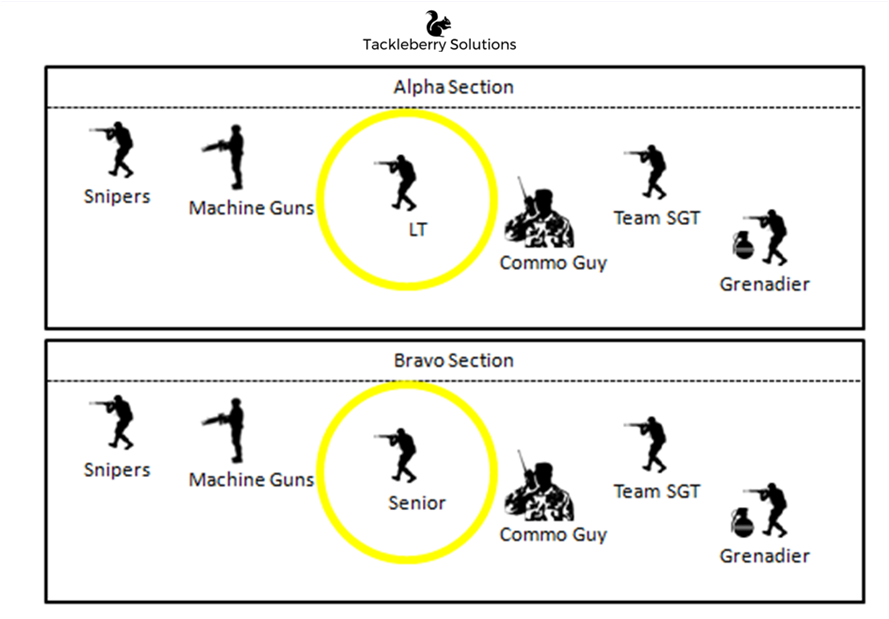
No matter how you break down your leadership within the platoon, just make sure you have two sections and they both have some form of experience and brains to command them.
You then break down the section with team 1 and team 2. Your team SGT commands team 2.
Next, you organize who is going to be on what team by the weapon system they are carrying. Snipers have long-range optics so they go to the front. Machine guns right behind them so they can lay down suppressive fire. Then comes the section commander and the commo guy. (Commo guy always stays with SC.) They are followed by the team SGT(In the event that the section has to split, the team SGT would command the sniper and grenadier.) Lastly, a grenadier (This guy would be carrying the grenade launcher). Again, so he can lay down suppressive fire to the rear.
Formations
Whether you are using a Ranger File or Wedge, remember to keep your personnel distance (this is known as intervals). Your intervals will keep you from losing half your element to a hand grenade or mortar round.
When traveling, you must use formations to ensure that you are keeping 360 security while in motion. You also want to present the hardest target possible. The risk of being attacked by a sniper while traveling in the open is high.
There are two main types of formations: the Ranger File and the Wedge. The Ranger File places your men in a line as they walk. The Wedge is exactly what it sounds like.
Your men will be walking beside each other in the shape of a wedge. This is very similar to the way you would see geese fly. Each one has a specific use and is advantageous depending upon the terrain.
The Ranger File is useful while traveling in dense vegetation and forests while the Wedge is better used when you are out in the open.
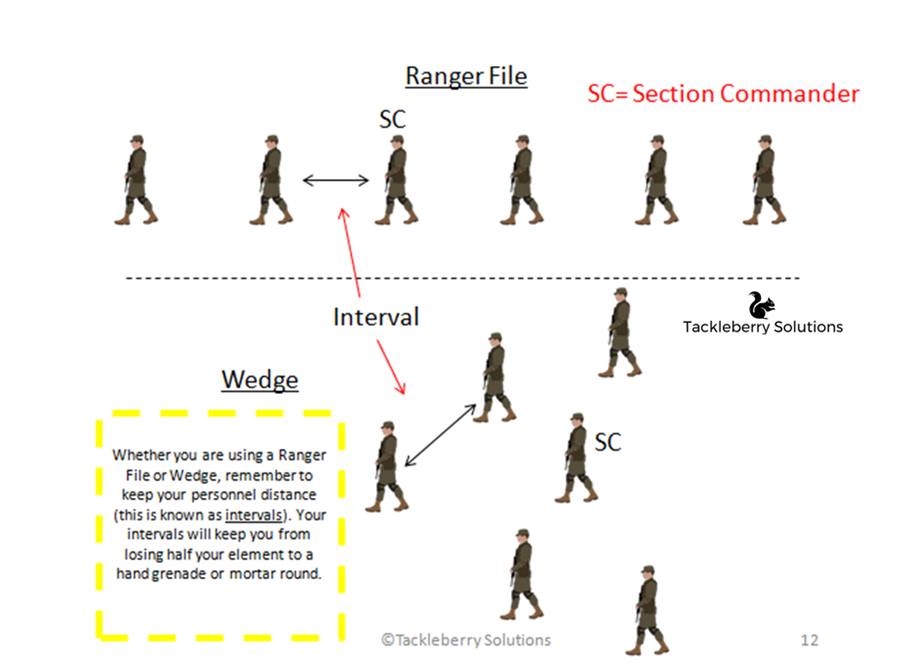
Stopping/Pausing While in Formation
You are a sitting duck while still. You should never stay in one place for any length of time. If you do have to be still, the ground is the safest place you could be. How long you’ve been still will determine your position. Teach your men the following time positions while stationary.
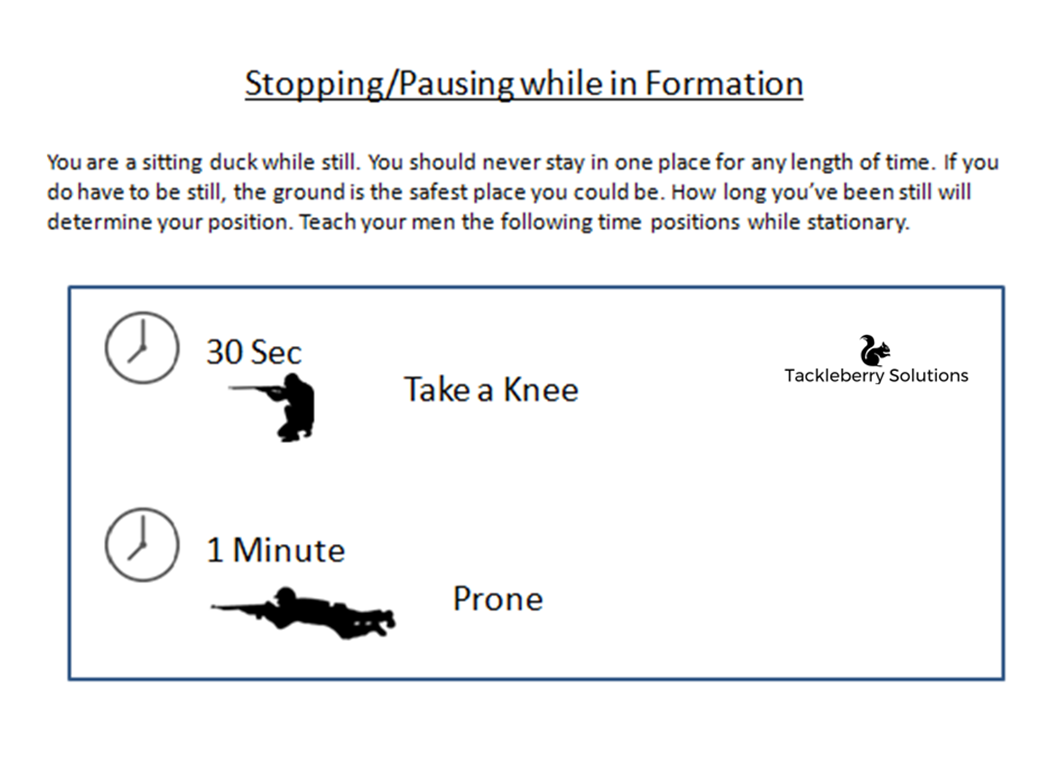
2 Man Wedge (Open Terrain)
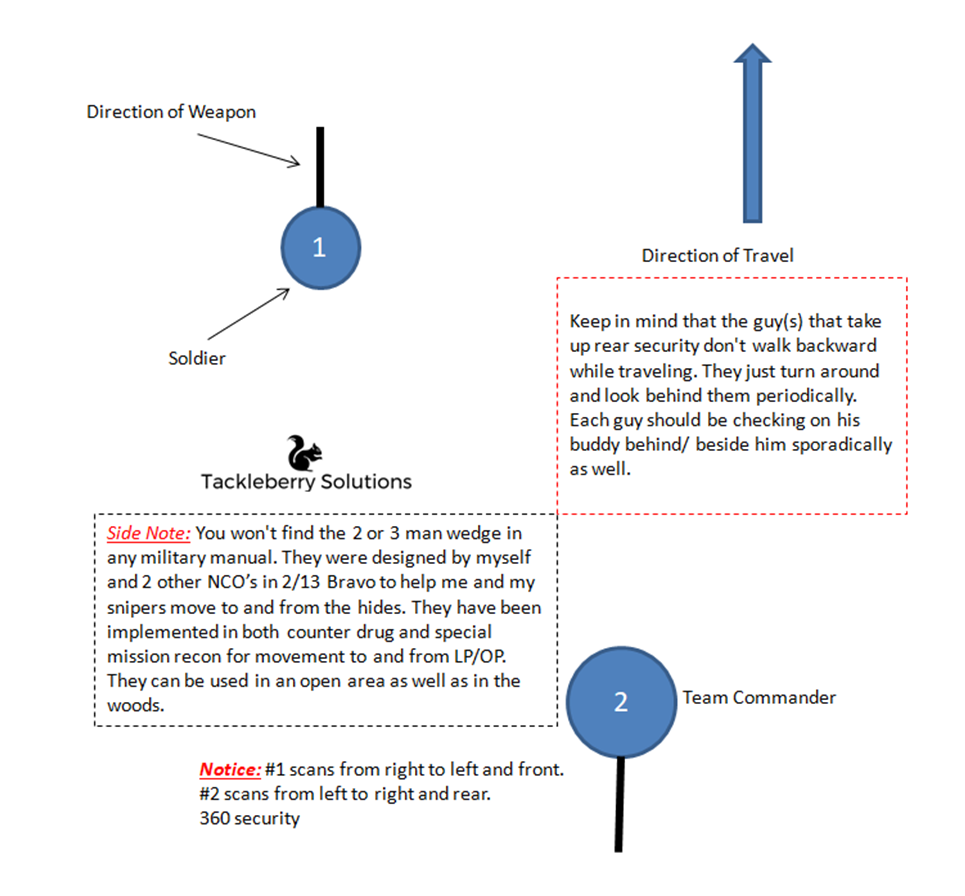
3 Man Wedge (Open Terrain)
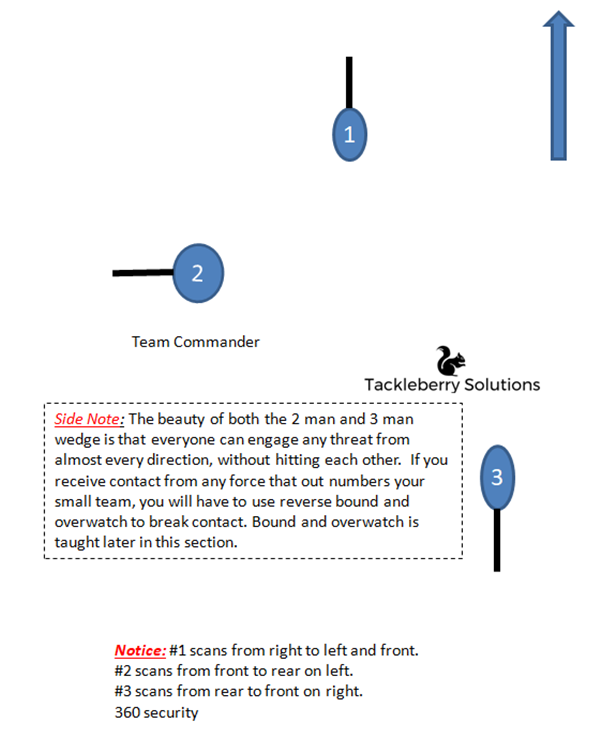
4 Man Wedge (The Diamond)
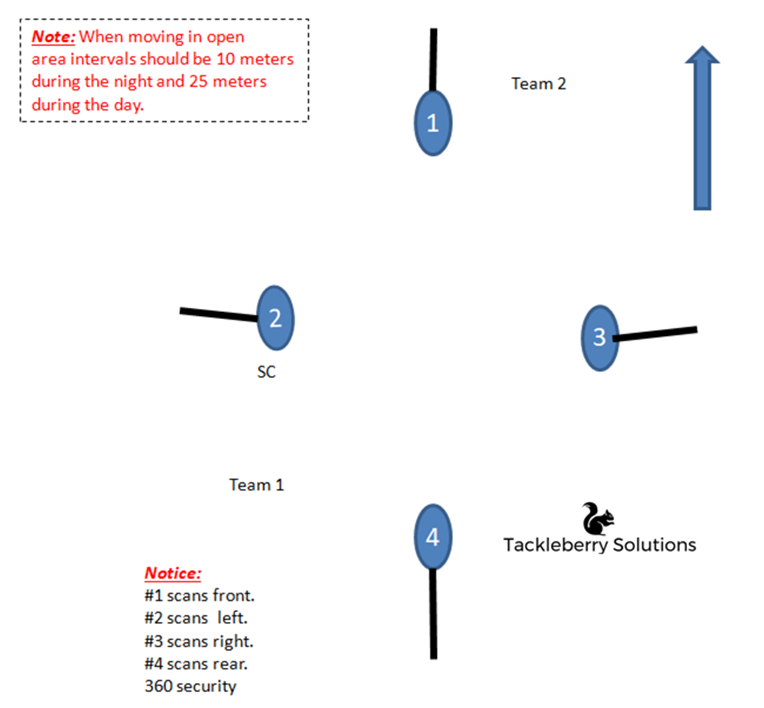
Standard Wedge (Open Terrain)
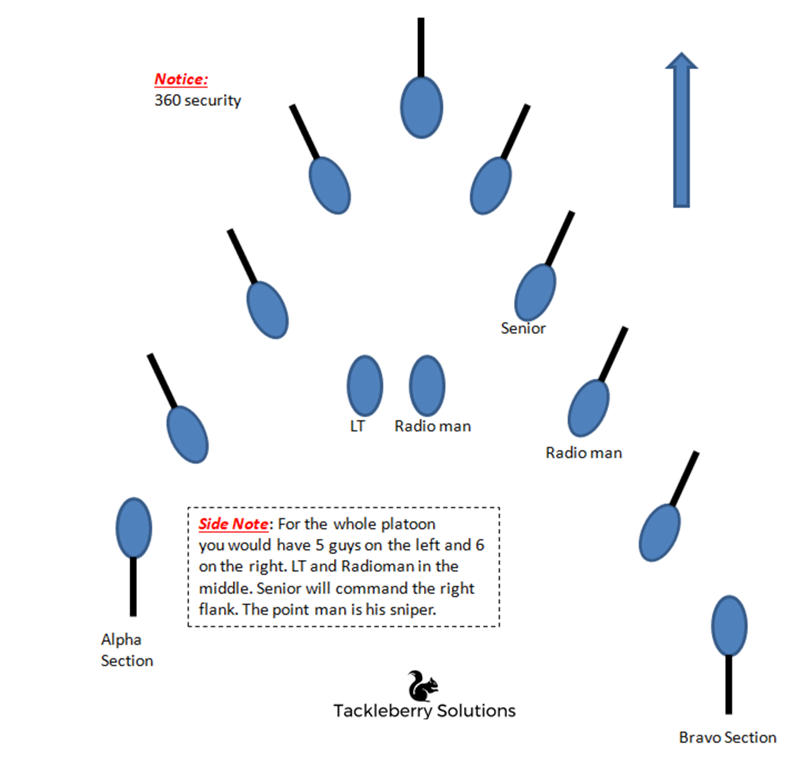
Ranger File (Bushy Terrain)
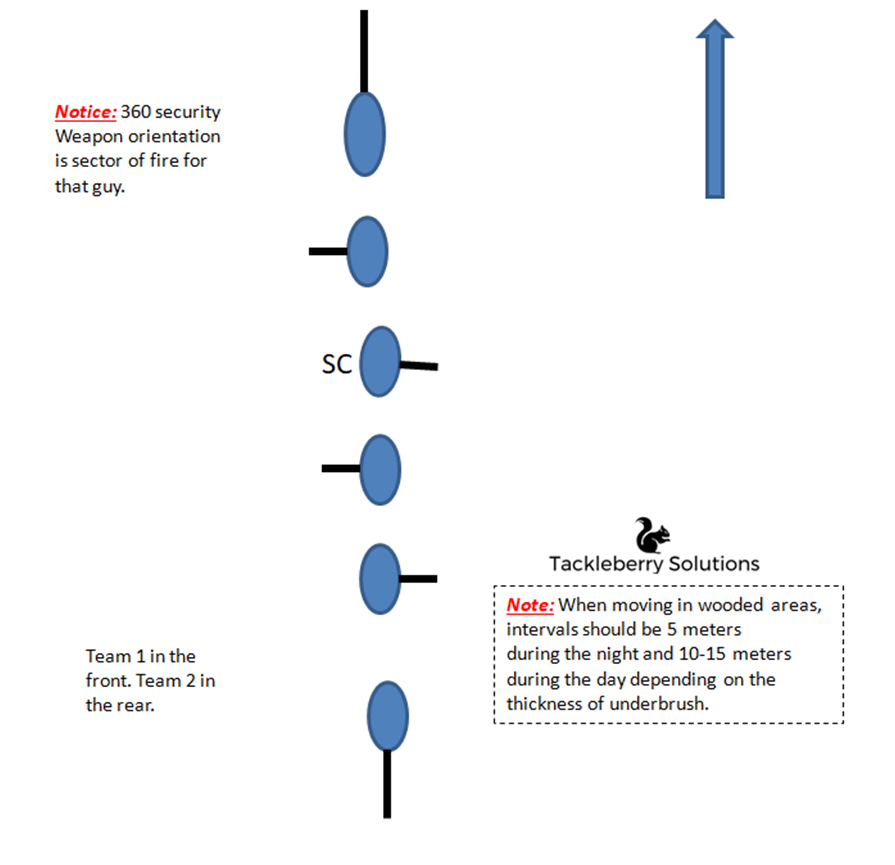
The Alpha Alpha
The Alpha Alpha is used for when you plan on being stopped for a while. Overnight, waiting to
link up with allied forces, etc. This allows you to see a threat coming from any direction. Also, if
you plan on an overnight stay, you can run 50% security by having every other guy on watch while
their buddy to their left and right are sleeping. LT and radio man are in the middle and rotate out
turns doing radio guard. (That’s monitoring for any and all radio traffic.) Side Note: If you're going to stop for the night, be sure to choose a location that will give you the best tactical advantage. i.e. a hill top.
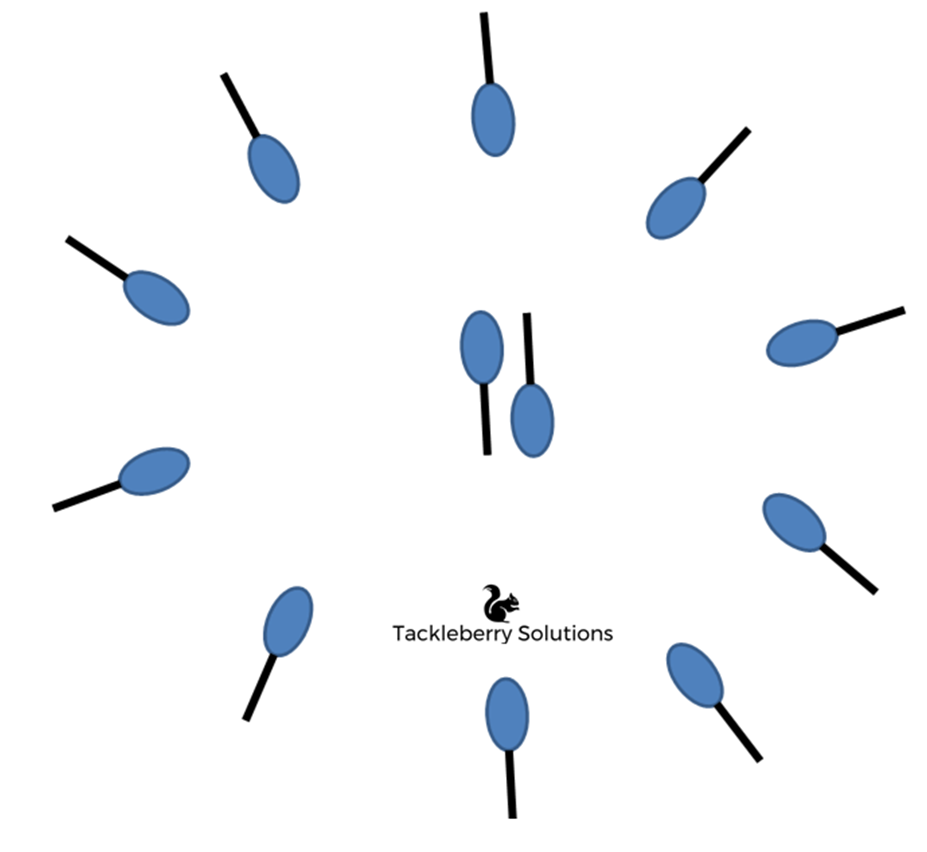
Little Tidbits That Could Save Lives
Distance in personnel (Intervals)
Daytime/ Normal visibility- 10-15 meters in between personnel while in woods and using ranger file. 25 meters while in the open and using wedge.
Night time/ Low visibility- 5 meters while in ranger file. 10 meters while in the wedge.
Effects of Explosives
Range of Explosives- In meters
Hand grenade= 5 kill, 25 wound
Claymore= 10 kill, 30 wound
Mortar round= 25 kill, 50-75 wound
Artillery= 50 kill, 100-150 wound
J-DAM- Don’t worry, yall ain’t going to make it.
Tactical Pausing
All along, you’re going to want to take a tactical pause. For about 1 minute. This is so the LT can get his bearings (as they are usually lost) and so the point man can have a minute to perform slls (pronounced seals). Stop, Look, Listen, Smell. Basically, just be observant, you might just find something. Performing slls has helped me many times from walking into something bad. It's amazing the intelligence you gather from just being still and observant.
When stopped, take a knee after 30 seconds, after 1 minute, lay down in the prone.
Side Note: If you can smell your enemy, you're within 25 yards of them or less.
What NOT To Do
• Don’t talk a lot. Noise travels, especially at night. I have found so many guys because they were talking. Think of this: You hear a big crash – “Tree falling?” You hear someone talking – “Everyone shoot that way!”
• Don’t use the same route of travel repeatedly. It creates a pattern, and that creates an opportunity for an ambush.
• Don’t take the path of least resistance. I know it sucks, but don’t use the roads, trails, or even a deer path. They are prime areas for an ambush or booby trap. If you're worried about getting lost, then you can handrail the road. That means to walk parallel to the road, keeping it about 50 meters away from you at all times.
• Don’t stand up in a firefight. Pat Tillman anyone? The ground is the safest place in a firefight. It makes you a smaller target and nothing stops bullets and shrapnel like good old dirt.
• Don’t engage the enemy unless you outnumber them 3 to 1.
Team Movement and Planning Ahead
Now that you've learned about creating your own platoon and how formations work, it is time to move on to team movement and planning ahead. Click here to read the next article.
Definitions/Terms
2-3 Second Rushing- “I’m up, he sees me, I’m down.” That what you say to your self as you run from one cover/concealment location to another. This is done so you can advance or retreat without getting shot. By the time the enemy gets his sights on you, you’re hitting the ground. Then your buddy jumps up and runs.
360 Security- Always maintain the ability to fire and scan in every direction. The fewer men you have, the more vigilant they must be in monitoring their sector of fire.
AUW – Advanced Urban Warfare are advanced tactics for fighting within an urban environment.
Baseline of Fire- a position usually formed by the Alpha team. All members come and form a line facing the enemy. Remember to keep 360 security. Then they use suppressive fire to keep the enemy heads down and attention on.
Bound and overwatch- One soldier shoots with suppressive fire while the other advances onto the enemy’s position, or retreats from their position. Often using 2-3 second rushing.
Breaking contact- basically you realize that you have bit off more than you can chew and wanta get the hell out of there alive. There are formations and tactics to do this properly. Bound and overwatch, Auzzy Peel, and Rolling Peel.
Casualty Collection Point- Predesignated location just outside the contact area of a raid sight, or locations along the route of travel, in which you will collect your wounded for treatment and stabilization for movement to a medical facility. Can also double as rally point.
CCT- Casualty Collection Team. A small team that usually consist of 3-4 guys that collect the dead or wounded during the fight. This is seen more often in AUW (Advanced Urban Warfare).
Choke Point – This is much like a fatal funnel, it is an area that you have no choice but to go through due to the natural terrain features. Example: a bridge over a large river.
Commo - communications
Concealment- A position behind an object that cannot stop bullets or fragmentation, but can act as a visual block. (i.e. tall grass)
Convoy - A group of vehicles traveling in the same direction for the same purpose.
Cover- A position behind an object that can stop bullets, fragmentation, and visual contact. (i.e. Rock)
cross-load ammo – This is like socialism, but with ammo. You will compile all of your ammunition and distribute it equally. This is typically done after a firefight.
Direct Fire- Precision incoming fire. Think J-Dam off a F-15 or rifle fire.
Dismounts – Men that get out of the vehicle and push forward on foot to either engage the enemy or clear an obstacle.
EPT- Enemy Prisoner Team. Similar to the CCT, but not as caring. They secure and search the POW again and move them (wounded or not) to the POW security point for yet another search, treatment, and evacuation for further interrogation. CCT can double as EPT.
Far Ambush- an attack that is outside of hand grenade range.
Fatal Funnel – This is like a choke point. It is an area that gives you no choice but to go through in which you have no option to go left or right. The only way out would be to push forward or go backwards.
Flanking- Moving toward the blind side of the enemy to gain tactical advantage.
FLIR Imagery – This is an advanced thermal optic used by drones and other aircrafts to spot personnel, weapon cashes or anything else that gives off a heat signature. This is very difficult to avoid.
Force on Force Training - Split your platoon in half and have one side defend, while the other side attacks. Be sure to use actual projectiles such as air soft, paint ball, or SIM rounds.
Formation- A specific placement of men to gain maximum tactical advantage.
Forward Operation Base (FOB) – Is a city within a city. Much like a standard military base here in America. Just this base is totally geared for war. Round the clock guards, stationary and roaming, TCP, etc.
Grenadier - Is the guy that carries the grenade launcher and grenades. Second most important weapon system in a fight. Can cause mass casualties with only one shot.
Indirect Fire- incoming fire that is from an arial weapon. Think artillery, mortars, or grenade launcher.
Intervals – distance between each person
KIA- killed in action.
KISS – Keep it simple stupid
Lift and Shift- A command given by team leader to fire high and away from your approaching troops. This keeps enemy’s heads down without hitting friendly forces.
Limit Of Advance – When advancing through an objective, this is an area where you stop your assault.
L-Shape- L shape ambush is when you literally place your men in a form of an L and let the enemy walk into your cross fire. With this shape, there is no way you can hit each other. But your enemy has nowhere to go and is getting hit from what seems like all sides.
LT – Lieutenant, the lowest rank that a commissioned officer can hold in the military. In my experience they are usually “GOOD IDEA” fairies and cost you more sleepless night and pain than any one else.
LOA- Limit of Advance. Tells the men in your section to stop movement, and commander of other section to start their assault.
LZ – Landing Zone for an aircraft.
Murphy’s Law – An old army wise tale. Anything that can go wrong will go wrong, it’s Murphy’s law.
NCO – Non-commissioned officer, where the rubber meets the road, the backbone of the military. The guy that puts foot to ass, trains the men, keeps them alive in a hot zone, and makes heroes out of LT’s.
Near Ambush- An attack that is within hand grenade range. I.E. I can throw a hand grenade and it kill the enemy.
Neighborhood Guardian – Is like the stationary or roaming guard. The watchdog of your community.
Package - A term used for the person/thing that is being protected or delivered.
Pat Tillman – Former NFL player that joined the Army Rangers after 9/11. Was killed in action during a firefight in Afghanistan. Stood up from behind cover in front of his team and was hit by friendly fire.
Platoon – Is a group of men that comprise of two sections of about 6 soldiers. They are headed by the platoon Sergeant and Lieutenant.
Platoon Leader Recon- when the LT, Senior, and a radio guy move forward to observe the objective while leaving the main body behind . This is done to prevent too much noise from excessive movement.
Point Man – The man that is at the front of your formation, this is typically a sniper.
POW- prisoner of war.
Prone - The most stable firing position and the safest during a firefight. Just lay down.
precision fire – Shooting carefully to aim and actually hit the target instead of just spraying lead.
QRF (Quick Reaction Force) – Modern day minutemen. You can also think of them as emergency responders during war.
Rally Points - Predesignated location for your men to fall back to. This would be used as a gathering point after a raid, breaking contact, or that one member that gets separated from the group. Can also be used as check points along the route of travel to ensure you are on course.
Ranger File – Think ducks in a row. Walking in a single file line. This is used in areas with thick under brush.
Reaction to contact – Reacting to enemy shooting at you. Depending on the situation, you will react a certain way.
RPK – Russian version of a squad automatic weapon, typically carried by their machine gunners.
Sector of Fire- The area in which you are responsible for and have free range of engagement.
Sig acts – Significant activities within the last 24 hours. Firefights, enemy activity, etc.
SLLS - Pronounced Seals, stands for Stop, Look, Listen, Smell. Basically just be observant, you might just find something.
Sniper- an enemy sharp shooter that uses concealment to hide their position while delivering procession fire on enemy.
Stationary Guards – Guards that sit in one location observing their sector of fire.
Stockholm's Syndrome- A state of mind prisoners can develop in which they sympathize with their kidnapper and no longer try to escape.
Suppressive Fire- one round a sec. This is designed to keep the enemy’s head down while your other section advances onto their position.
S vest - Suicide vest. A vest that is rigged with explosives, designed to be worn by individuals willing to blow themselves and others up .
TC - Truck or Track Commander
Thermal Sighting Imagery – Optic system used to see day or night based upon your body’s heat. Does not work through glass or any kind of obstruction. Also faulty in the desert at high noon as everything is hot.
Triage – This is where you assess the wounded in mass amounts so that you know who to treat first that have a better chance of living.
Train to Failure – Train as if everything is failing you. Radios die, weapons jam, no support, medic is dead, etc.
Victim Detonated – Basically a booby trap that is detonated by the victim themselves be it via trip wire, thermal imagery, pressure plate, etc.
VIP - Very Important Person
Wedge Formation - Formation used when in the open. Designed to look like a wedge. Gives you more of a chance of surviving a sniper ambush.
Side note: When you get into contact with the enemy just yell out your commands. The enemy knows you’re there anyways. Be sure that the command is repeated back to you by the rest of the group. This is to ensure they understood the order and to give anyone that didn’t hear it a second chance at hearing the order. Furthermore, dig deep, grab your balls and sound off. Use your man voice. When all hell is breaking out around you and guys are dying, no one is going to hear or listen to you if you sound like freaking Mickey Mouse.
